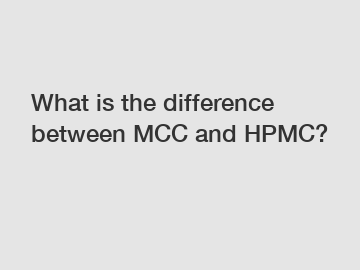Jan. 13, 2024
Chemicals
What is the difference between MCC and HPMC?
MCC and HPMC are two commonly used materials in the pharmaceutical and food industries. While they may sound similar, they have distinct characteristics and applications. Today, we will explore the key differences between MCC (Microcrystalline Cellulose) and HPMC (Hydroxypropyl Methylcellulose) to gain a better understanding of their individual properties.
MCC and HPMC are cellulose-based compounds that serve as additives or excipients in various products. Both are derived from natural sources and are widely regarded as safe for consumption. However, they differ in terms of their production methods, chemical structures, physical properties, and applications.

MCC is made by depolymerizing cellulose from wood pulp or plant fibers, followed by purification and spray drying. It typically appears as a white, odorless, and tasteless powder. In contrast, HPMC is synthesized by treating cellulose with propylene oxide and methyl chloride, resulting in a range of products with varying viscosities and properties.
Now, let us delve into the key points of discussion regarding their differences:
1. Chemical structure:
- MCC consists of microparticles of cellulose, with crystalline and amorphous regions. It exhibits high chemical stability and is resistant to pH changes.
- HPMC is a modified cellulose compound, where hydroxyl groups are substituted with hydroxypropyl and methyl groups. This modification imparts unique properties, such as improved solubility and gel-forming ability.
2. Physical properties:
- MCC has excellent compressibility and binding properties, making it an ideal ingredient for tablet formulations. It helps in maintaining tablet integrity and controlling drug release.
- HPMC, with its film-forming and thickening properties, is often used as a coating material for tablets. It provides a protective layer and controls the release rate of active ingredients.
3. Applications:
- MCC finds extensive usage as a filler, binder, and disintegrant in tablet formulations. It improves tablet hardness, enhances flowability, and promotes rapid disintegration.
- HPMC serves as an emulsifier, stabilizer, or thickener in various food and pharmaceutical products. It is commonly used in ophthalmic solutions, oral liquids, creams, lotions, and dietary supplements.
4. Compatibility:
- MCC and HPMC have different compatibility profiles with other ingredients. MCC has limited compatibility with certain active pharmaceutical ingredients (APIs) due to its compact structure, while HPMC exhibits better compatibility with a wider range of APIs.
In conclusion, though MCC and HPMC are cellulose-based materials, their unique properties make them suitable for different applications. MCC is primarily used in solid dosage forms, offering improved tablet hardness and disintegration properties. On the other hand, HPMC finds broader use in various pharmaceutical and food products, providing film-forming, viscosity modifying, and stabilizing effects.
Next time you come across these abbreviations, you will have a better understanding of the differences between MCC and HPMC. Remember, the choice between the two materials depends on the specific requirements and formulation needs of the product at hand.
Contact us to discuss your requirements of HPMC for wall putty, HPMC manufacturer, OEM HPMC cellulose. Our experienced sales team can help you identify the options that best suit your needs.
Previous: Is Carbon Black Oil the Next Green Energy Revolution?
Next: Which Unconventional Uses of Compound 234108-73-7 Could Revolutionize Industries?
If you are interested in sending in a Guest Blogger Submission,welcome to write for us!
All Comments ( 0 )